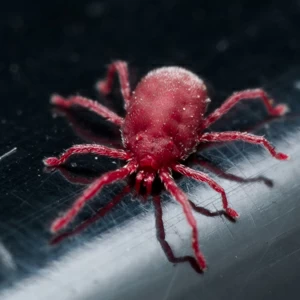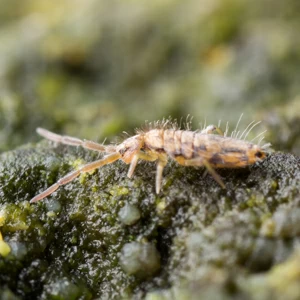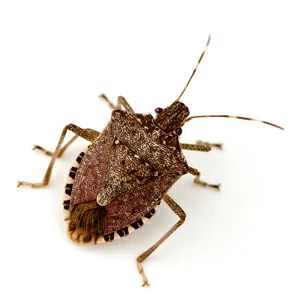


Bugging
You?
Occasional Invaders
Occasional invaders come in many shapes and sizes. They invade structures when the outside environment becomes too unfavorable for their survival or to overwinter. They enter the structure through utility penetrations, soffits, loose siding, cracks and crevices, improper door sweeps, missing caulk, holes in screens, firewood, and potted plants that may be brought inside.
Since they live and reproduce outside, they become a nuisance when they move inside and bite, pinch, contaminate food, stain clothing, damage household goods, or create foul odors. Our team uses a variety of control measures to eliminate these occasional invaders. Let our professionals protect your living environment when these invaders decide to make your home their home!
Occasional Invaders Identification
Though they aren’t often common pests, occasional invaders can still become a nuisance. The first step to rid your location of any pest is to identify what kind of pest you have on your hands. The following are some common occasional invaders you may experience.

Asian Lady Beetle
Identification Tips:
- Color: They have a broad spectrum of colors from red and orange to a dull cream and can have a varying number of spots
- Legs: 6
- Size: About 1/4-inch long
- Identifying Characteristics: Asian lady beetles can be identified by their “M” shaped mark behind their head
Characteristics of this insect:
- The USDA, the Forestry Commission, and private agencies have released these lady beetles in several parts of the US as an alternative to pesticides to relieve the hardwood forests and various food crops of harmful insects
- When these beetles feel threatened, they release a foul-smelling chemical to deter predators. The fluid can create orange stains, making them a nuisance when entering your home.
- Asian lady beetles have been known to seek out crevices and cracks to invade homes, attics being a familiar place, during the winter months to seek warmth and shelter. In the fall and spring, these critters will swarm along buildings. They like to rest on the sides of buildings where the light hits during the afternoon sun.
- These beetles do not reproduce indoors, and they do not attack wood, food, or clothing. They are more of a nuisance to homeowners. However, hygienic establishments such as hospitals do not tolerate contamination.

Centipedes
Identification Tips:
- Color: Grayish yellow
- Legs: 15 pairs of long legs
- Size: Adults measure 1 to 1 1/2 inches long
- Identifying Characteristics: 3 dorsal longitudinal dark stripes; antennae and last pair of longs longer than its body; sometimes called “a hundred leggers”
Characteristics of this insect:
- Actually, not an insect. They are more closely related to lobsters, crayfish, and shrimp.
- Outside, found in areas that retain moisture, such as under stones, beneath loose bark, under porches, under piles of leaves or grass clippings, and mulch, to name a few.
- Inside they can be found all over, but critical places are the basement, bathrooms, crawlspaces, and other damp, dark areas.
- A beneficial insect that feeds on tiny insects and spiders. However, due to being frightening to people, they are controlled once inside.
- After over-wintering, the house centipede will lay eggs in or on the soil, usually in the summer. They can produce approximately 35 eggs over a day.

Clover Mites
Identification Tips:
- Color: Bright to dark red or rusty brown
- Legs: Four pairs of legs; pair of front legs are as long as its body or twice as long as the other legs and move like antennae
- Size: Adults measure less than 1/16 inch long
- Identifying Characteristics: Leave red stain or streak when smashed; look like little, dark red moving dots.
Characteristics of this insect:
- No male clover mites in the USA. Females lay about 70 eggs through summer and autumn. Eggs laid in the fall will hatch the following spring.
- Prefer grass and common weeds adjacent to the structure. It will build up on the south side of the system where it is warmer than 69 degrees Fahrenheit on sunny days and when the air temperature is lower. When temperatures exceed 75 or below 45 degrees Fahrenheit, egg and mite development and activity suspend.
- Clover mites excel in new subdivisions landscaped by seeding or raking bare Earth. Also, well-fertilized lawns help contribute to the mites’ success. They will enter the structure through cracks in foundations, underneath sheathing, or windows or doors where the caulk may have cracked.
- Clover mites are primarily plant feeders, feeding on 200 different plant species.

Earwigs
Identification Tips:
- Color: Light red-brown to black with paler legs, antennae, and wing covers
- Legs: 6
- Size: 1/2 – 3/4 inches long
- Identifying Characteristics: Easily recognized by their forceps-like pinchers at the end of their abdomen; adults are winged and common in Midwest
Characteristics of this insect:
- They are active mainly at night and are found around lights. During the day, they hide in moist, shady places such as under stones, landscape rocks, or mulch
- During spring or autumn, females lay 20 to 50 eggs in the below-ground chamber. Both eggs and adults overwinter
- They feed on mosses, lichens, algae, fungi, and small insects, both dead and alive
- They are capable of producing foul-smelling, yellowish-brown liquid from their scent glands

Millipedes
Identification Tips:
- Color: Light brown to black
- Legs: Most body segments have two pairs of legs (usually 30-90 or more pairs of legs
- Size: Species vary in length from less than 1-2 or more inches
- Identifying Characteristics: Wormlike; the head is rounded with short antennae; often called “thousand-leggers” or “rain worms.”
Characteristics of this insect:
- Actually, not an insect. They are more closely related to lobsters, crayfish, and shrimp.
- Millipedes are not poisonous, but many species have glands capable of producing irritating fluids that may cause allergic reactions.
- They are considered scavengers that feed on decaying vegetation and leaf litter, although some species may attack the roots of living plants.
- Millipedes spend most of their time in soil, where they overwinter. In the spring, 20 to 300 eggs are laid in the ground.
- They may build up in large numbers, migrate in dry weather, and enter basements, ground floors, and window wells. They are a particular problem for homeowners situated in a woodland setting.

Pillbugs and Sowbugs
Identification Tips:
- Color: Brownish or slate gray
- Legs: 7 pairs of legs
- Size: Up to 3/4 inch long
- Identifying Characteristics: 2 pairs of antennae; Both look like little armadillos, but only the pillbug can roll into a tight ball; Sowbugs have two taillike appendages on the rear end, while pillbugs do not.
Characteristics of this insect:
- Both are slow-moving and are related to crayfish, shrimps, and lobster (crustaceans), not insects
- Live mainly outdoors, protected by objects outside, and feed primarily on decaying and live vegetable matter and fungi. Adequate moisture is critical to their survival.
- Heavy infestations outside cause them to find their way inside structures. Inside they will migrate to damp areas, including basements, first floor, and garages, to name a few.
- Both mate throughout the year, with the most activity occurring in the spring. Females lay between 7-200 eggs, capable of taking care of themselves in eight weeks. There are two generations per year.
- Adults can live up to three years, depending on environmental conditions.

Silverfish
Identification Tips:
- Color: Covered in silver or gray scales
- Legs: 6
- Size:Adults measure 1/2 to 3/4 inches, not including their tails
- Identifying Characteristics: Long antennae in front with three bristle-like appendages on the rear of their body; teardrop shape
Characteristics of this insect:
- This insect prefers dark, humid areas (50 to 75% relative humidity) with temperatures between 70 and 80 degrees
- They feed on starchy substances such as flour, glue, paste, and starch sizing on textiles. This insect can digest cellulose fibers.
- They build up around feeding areas. Their feeding leaves were irregularly shaped, yellow stained holes in textiles and paper, surfaces removed from corrugated cardboard, and the irregular regions grazed off clothbound books. Damaged products may have fungus growing due to humidity and fecal deposits.
- Silverfish lays 1 to 3 eggs daily, or nearly 1,000 per year. Most silverfish can live up to 3 years.

Spiders
Spiders are a common pest marked by eight legs, a circular body, and fangs. There are over 35,000 described species of spiders worldwide, with about 3,000 occurring in North America. All spiders are predators who invade homes to feed on insects and other small arthropods. Upon invasion, spiders seek the dark, moist, or dry areas of the basement and attic of your structure. Most spiders are nocturnal or active at night and will scurry away when disturbed unless they are tending egg sacs or young. During the day, they usually remain hidden and inactive in cracks and crevices, their webs, etc.
Only two spider groups in the United States are considered dangerous to humans: widow spiders and recluse spiders. If spiders invade your home, please follow these procedures:
Identification Tips:
- Inspect your structure (preferably at night as they are nocturnal)
- Identify the species (use our Upload Your Bug link, and we can identify it for you)
- Implement preventative steps such as repairing torn screens, caulking gaps, utilizing yellow bulbs, etc.
- Keeping premises free of debris such as boxes, papers, clothing, etc. Outside, remove junk, leaf clutter, stacked firewood, and keep the grass mowed to 3.”
- Mechanically remove spiders, webs, and egg sacs.
- Appropriate application of the product by a professional applicator like Apex

Springtail
Identification Tips:
- Color: A range of colors from white to black. Some species are purple, red, orange, grey, yellow, or multicolored
- Legs: 6
- Size: range in size from 0.2 mm to 10 mm
- Identifying Characteristics: Springtails require high-humidity environments such as mulch and damp lawns. They feed on molds, mildew, fungi, decaying vegetable matter, and sometimes decaying animal matter such as earthworms. Occasionally they can cause damage to greenhouses and cultivated mushrooms.
Characteristics of this insect:
- These critters have two main body shapes: either elongated and cylindrical or spherical and compact
- Has an abdominal appendage called the furcula propelled the springtail through the air? This is used as a means to evade predators as it can propel the springtail up to 100 times its body length/li>
- If temperatures rise high enough, Springtails can reduce their body size by 30% through molting.
- Springtails sometimes enter homes with high humidity and mold growth. This is more commonly found in bathrooms and basements.

Stink Bug
Identification Tips:
- Color: Colors range from lime green to inky black. A spotted brownish-grey color identifiess some.
- Legs: 6
- Size:1/3 – 3/4 inches in length
- Identifying Characteristics: Stink bugs are named for a foul-smelling compound that they expel when they feel threatened. As this smell deters predators, it also sends a chemical message to other stink bugs to alert them to danger. The scent also plays a role in attracting mates.
Characteristics of this insect:
- Known for its “shield” shaped body
- Stinkbugs can be a mixed blessing to gardeners as they feed on plants and other insects. They damage various fruits and vegetables, and they can overpower caterpillars or beetle larvae.
- Stink bugs do not bite humans. However, they can produce allergic reactions in some people who are sensitive to the bugs’ odor. If the insects are crushed against exposed skin, it has been reported that it can cause dermatitis at the point of contact.
- The most common complaint is their foul odor when disturbed or the noise they make when they fly around.
- In homes, stink bugs can be found in cracks and crevices around windows and door trims. Stink bugs will not reproduce inside structures or cause significant structural or cosmetic damage to your home.
